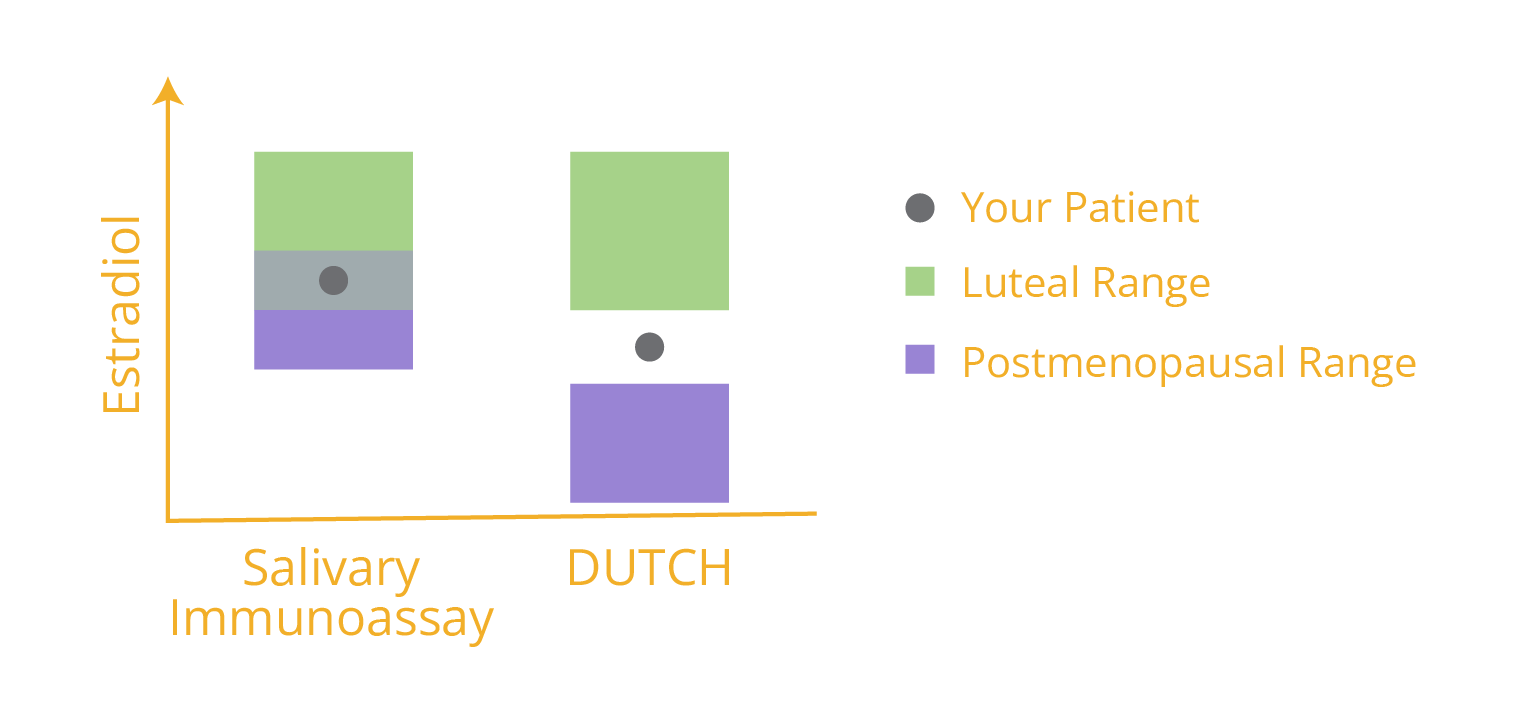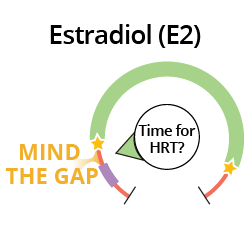The simplified DUTCH Report has arrived, and current DUTCH Providers are eligible for up to 5 DUTCH Complete or DUTCH Plus test kits for 50% off. Learn more and claim this offer!
Know Your Lab’s Reference Ranges When Prescribing Estrogen Replacement Therapy
Mark Newman, MS
Know Your Lab’s Reference Ranges When Prescribing Estrogen Replacement Therapy
by Mark Newman, MS
Mind the Gap: Meaningful Differentiation with DUTCH
Whether you've been prescribing hormone replacement therapy (HRT) in your treatment plans for a while, or you're just starting to understand it, there is a lot you need to know. Measuring and tracking a patient’s estradiol levels is crucial to evaluating her need for HRT. The gap between estrogen deficient and estrogen sufficient women is significant, but can your lab “see” it?
When ordering hormone tests, it’s important to get a complete picture of reference ranges. These ranges can help you see if your patient is estrogen deficient or sufficient and give guidance on whether she would benefit from HRT. That way you can confidently provide care for even the trickiest of cases.
Saliva vs DUTCH - A Case Study
Let’s dive into one of those difficult patient presentations. Imagine a 49-year-old female patient comes to you with symptoms like hot flashes and night sweats. She’s worried about long term bone loss and is interested in hormone replacement therapy.
The way you proceed with your diagnosis and treatment plan is critical to your patient’s well-being and the health of your practice. If you order any commercially available saliva test for estradiol, you might find that her results fall in a gray area between both the postmenopausal (PMP) and luteal ranges. What do you do?

Defining the patient as estrogen sufficient or estrogen deficient is not possible in this situation. Without meaningful differentiation between these two ranges (postmenopausal and luteal) you run the risk of misdiagnosing your patient. It’s difficult to move forward confidently with treatment plans when you can’t obtain definitive results from your hormone test.
DUTCH testing is different. The accuracy of our testing provides postmenopausal and premenopausal (luteal) ranges without any overlap and a significant “gap” between them to help you precisely characterize your patient’s estrogen status. This gap doesn’t exist in available saliva testing and is an important piece of information that can help you prescribe and treat effectively.
DUTCH providers have an edge over other clinicians—DUTCH clarifies the blurred lines between estrogen sufficient and estrogen deficient that other tests can’t define.
Dissecting the DUTCH Dial
Healthcare providers can accurately determine their patient’s hormone status by looking at their DUTCH report. Patient results are displayed on a dial with reference ranges that correspond with postmenopausal and luteal levels of estradiol. Providers can use the arrow at the center to see where their patients fall on the dial and assess whether their estradiol levels are in the PMP or luteal reference ranges.

With an LC/MS assay, the DUTCH Test can detect nanogram-level hormone concentrations that show a distinct gap between PMP and luteal reference ranges, an important bit of information that can affect treatment decisions and hormone replacement therapy dosage recommendations by providers. This level of distinction is lost with salivary estradiol testing and can add more clarity to a patient’s hormone status.
Understanding the Gap
Does your current hormone test include this gap? Your goal as a clinician is to heal and alleviate uncomfortable and troublesome symptoms. In the case of our sample patient, symptoms like fatigue, brain-fog, hot flashes, and night-sweats.
This is difficult to accomplish when postmenopausal and luteal levels seem to exist in the same space for many of the most commonly used lab tests. Without meaningful differentiation between these two reference ranges, HRT dosing becomes difficult, even dangerous.
In our recent publication , we've shown the gap between PMP and luteal ranges for women is tremendously helpful for the dosing of hormones. Clinical studies have proven that the lower doses that move PMP women into “the gap” have mild clinical impact and doses pushing E2 levels to the top of the gap and into the luteal range have moderate to high levels of clinical impact. As providers steer their patients towards their treatment goals “the gap” can be used as a conservative ERT target range.
Providers should remember to "mind the gap” and look at their lab's reference ranges for a clear line between these two very different phases of a woman's life. Getting this diagnosis wrong could be harmful to your patient and damaging to your practice.
Nano-level accuracy brings HD quality to HRT


The Value of Meaningful Differentiation
Acknowledging the gap between PMP and luteal estrogen levels is an important part of hormone testing. Doreen Saltiel, MD, JD, a DUTCH provider and expert clinician believes this distinction between reference ranges is necessary for practitioners to consider.
"B ecause sex- hormones cycle and vary throughout a patient’s life , understanding where they are in their reproductive age helps with treatment. The most difficult group to differentiate are perimenopausal females. Most serum assays are immunoassays , and the premenopausal and postmenopausal reference ranges overlap, which makes it very difficult to tell if a female is perimenopausal. Keep in mind that LC-MS/MS serum assays are more accurate than this. "
In addition to the meaningful differentiation offered by DUTCH testing, physicians love the other health insights the DUTCH report provides. Doreen Saltiel describes how she uses the DUTCH Test in her practice:
"As a practicing clinician, I cannot optimally care for patients without the DUTCH T est. The DUTCH T est provides important insights into the HPA - axis with the diurnal cortisol pattern and cortisol metabolites. Most patients have some degree of HPA - axis dysfunction and without understanding its impact, patients often do not improve. In addition, understanding a patient’s sex-hormone metabolic footprint will allow for optimizing detoxification pathways and methylation activity, so as to decrease the likelihood of sex-hormone related adverse effects."
Do Hormone Replacement Therapy Better With DUTCH
You can build confidence in your HRT practice with the meaningful differentiation offered through DUTCH testing. With the accuracy to separate PMP and luteal reference ranges, you can draw conclusions about hormone replacement therapy protocols and dosages.
To learn more about how DUTCH can be used for hormone replacement therapy, watch Dr. Doreen Saltiel's webinar all about Menopausal Hormone Replacement Therapy.
TAGS
Women's Health
Postmenopausal Women
Menopause
Hormone Replacement Therapy (HRT)
Functional Laboratory Testing: General
Laboratory Testing: In-Depth Look at DUTCH Urine Testing